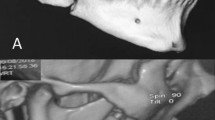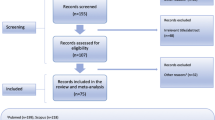Abstract
Data sources Medline, Embase and references of relevant articles.
Study selection Reports were selected if they were cohort studies reporting mandibular angle fractures in people with and without third molars. Case–control studies and case series that provided information about the proportion of people who had a third molar among the total suffering angle fractures and those without angle fractures were included.
Data extraction and synthesis Odds ratios and 95% confidence intervals were calculated from study data and results summarised using Mantel–Haenszel fixed-effects models and DerSimonian and Laird random-effects model. Formal heterogeneity tests were also carried out.
Results Six studies, all case series and involving 3002 patients with mandibular fractures, met the inclusion criteria (see Table 1). Crude relative risk estimates for an angle fracture, comparing patients with a third molar with those without, ranged from 1.2 to 12.7. There was significant heterogeneity across the six studies (P=0.001), but when two less methodologically rigorous studies were excluded this was no longer the case (P=0.22).
Conclusions The presence of a lower third molar may double the risk of an angle fracture of the mandible. This could have a bearing on any clinical decision on whether to extract the molar.
Similar content being viewed by others
Commentary
In evaluating the association between mandibular angle fractures and third molar (M3) status, it is reassuring to see the odds ratios clustering about a value of 2.8 across several studies composed of disparate samples. We also recently had a manuscript accepted for publication that confirms the authors’ findings. In our work, with a sample of 1450 subjects, people who had fractured mandibles and M3 s present had an unadjusted 2.2-fold increase in the risk of angle fractures compared with people who did not have M3 s (relative risk, 2.2; 95% confidence interval, 1.9–2.7; P<0.001). The adjusted odds ratio for the risk of an angle fracture given M3 s present was 2.8 (95% confidence interval, 2.3–3.4; P<0.001).1 The adjusted odds ratio was nearly identical to the pooled odds ratio computed in this manuscript. We believe that the weight of the evidence supports the association between mandibular angle fractures and M3 status (present or absent).
I have a few issues regarding this paper that probably do not affect the overall interpretation of the results. One stated purpose of the study was, “to estimate the risk of mandibular fracture among people with a third molar present compared with those without a third molar”…. This goal could not be achieved given the study design, because all of the subjects enrolled had to have a mandible fracture present to be included in the study. From reading the paper, I believe that the authors were interested in the risk of angle fractures, not just mandible fractures.
It is unclear to me why the authors chose to use the case–control study design. Case–control studies are used in the setting where the outcome of interest is rare. Mandible fractures are not a rare condition. Given the case–control model, one uses odds ratios to estimate the risk of the outcome, given the exposure. In many of these studies, I believe that relative risk is the better estimator of risk than the odds ratios.
I also do not agree that these studies are case series. Several of them meet the definition of a cohort study (retrospective) with heterogeneous exposures, ie, a study composed of subjects with a common characteristic (mandible fractures) and at least one exposure that can be measured (M3 status). From a practical standpoint, a case series can only produce descriptive statistics. Analytical statistics can be computed in the setting of a cohort study.
Finally, from a public health standpoint, extracting M3 s to prevent mandibular angle fractures is a peripheral issue and should only be considered in the setting of subjects in high-risk activities, such as contact sports. I do support, however, the universal use of protective mouthguards to decrease the risk of mandible fractures in the setting of high-risk activities.
Practice point
-
The presence of a lower third molar increases the risk of an angle fracture of the mandible.
References
Halmos DR, Ellis E, Dodson TB . Mandibular third molars and angle fractures. J Oral Maxillofac Surg 2004 (in press).
Author information
Authors and Affiliations
Additional information
Address for correspondence: Dr Beate P Hanson, AO Clinical Investigation and Documentation, Clavandelerstrasse, CH-7270 Davos Platz, Switzerland. E-mail: beate.hanson@aofoundation.org
Hanson BP, Cummings P, Rivara FP, John MT. The association of third molars with mandibular angle fractures: a meta-analysis. J Can Dent Assoc 2004; 70:39–43
Rights and permissions
About this article
Cite this article
Dodson, T. Third molars may double the risk of an angle fracture of the mandible. Evid Based Dent 5, 78 (2004). https://doi.org/10.1038/sj.ebd.6400263
Published:
Issue Date:
DOI: https://doi.org/10.1038/sj.ebd.6400263
This article is cited by
-
Transbuccal Approach in Management of Mandible Angle Fracture
Indian Journal of Otolaryngology and Head & Neck Surgery (2020)
-
Complication rate in mandibular angle fractures—one vs. two plates: a 12-year retrospective analysis
Oral and Maxillofacial Surgery (2018)



